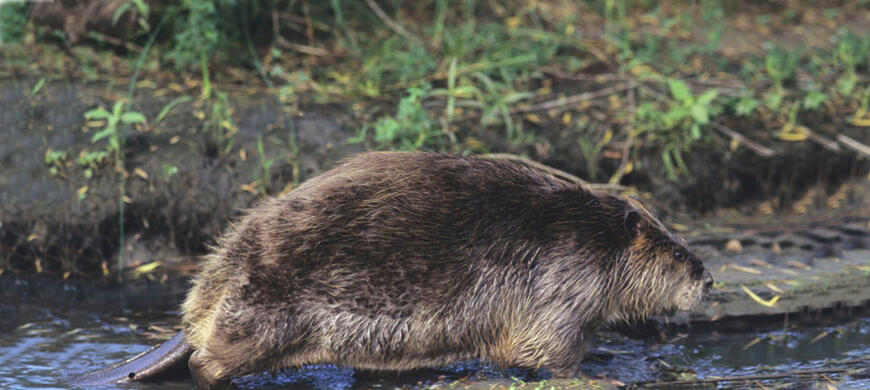Beaver

The most highly sought-after natural resource in North America during the 1700s and 1800s, the beaver's ( Castor canadensis) dense fur was used to make the felt hats considered fashionable in Europe at the time. Beaver populations were dangerously low by the late 1800s, but through conservation efforts, have rebounded even to the point of overabundance in some areas. In Kansas today, beavers inhabit various waters throughout the state.
Noted as the largest rodent in North America, beavers commonly weigh 40-60 pounds and have been known to reach weights of nearly 100 pounds. The beaver is the most specialized of all rodents for life in the water. Its flat, leathery tail and large, webbed hind feet are perfectly suited for swimming, and membranes in the ears and nose close while underwater. The beaver?s dense, tan to chocolate brown fur traps air to keep water off its skin, providing insulation from near-freezing water temperatures during cold winter months.
Beavers usually live in family groups consisting of an adult pair and one or two generations of young, totaling four to eight beavers. The young, or kits, are usually born in April or May, and average three or four per litter. The home range or territory of the group usually consists of a pond or a stretch of river or stream, and is scent-marked with castoreum (emitted from the castor sacs) and defended against intruding beavers.
In northern climates, beavers often live in "lodges," but in Kansas where steep banks are common, beavers usually burrow dens into the side of pond dams or river banks. The beaver's "food cache" can usually be found nearby. The food cache consists of a pile of sticks and branches collected in the fall and stashed underwater for winter use. The cache is the beaver's only source of food when the water's surface has iced over. The cache is always located close to the den, which is the beaver's air source during these times.
The beaver's instinctive dambuilding behavior makes it one of the most ecologically important wildlife species. The dams, which are constructed with sticks and mud, back up water to flood woodlands or surrounding habitat. While these beaver ponds help maintain water supplies during drought periods and create excellent habitat for a variety of fish and wildlife, they often conflict with the interests of man - especially when the flooded area consists of roadways, parks, or valuable agricultural land.
Exclusively herbivorous, beavers feed on a variety of plants, grasses, forbs, and even agricultural crops. But it is their taste for tree bark that has drawn them the most attention, and in some cases, ire, over the years. Beavers utilize many species of trees, but young willows and cottonwoods are among the most preferred in Kansas. Felling trees allows beavers access to the smaller, more nutritious branches in the canopy, and provides materials for dam, food cache, and lodge construction.
Beavers seldom venture far from the protection of water, and warn others of danger by slapping their tails on the surface of the water. In Kansas, only bobcats and coyotes prey on adult beavers, though other species may prey on the kits. Tularemia is a disease that can negatively impact beaver populations, and beavers are common carriers of the Giardia parasite that causes a human water-borne illness known as "beaver fever."
The beaver is an economically important furbearer because of the value of its pelt and the damage it inflicts through flooding and treecutting activities. About 10,000 Kansas beavers have been harvested annually since the mid 1990s, many of which are taken in damage control situations. Beavers may be taken only by trapping, and their harvest season is longer than that of other furbearers. They are widely regarded as one of the most palatable of Kansas furbearing animals.
Field Trail Permit - Furbearers and Coyotes.
Furbearers and Coyotes - Management Units
Hunting, Furharvestion, and Discharge of Firearms.
Furharvester License - Unlicensed Observer and Restrictions.
Furbearers - Open Seasons and Bag Limits.
Coyotes - Season
Nonresident bobcat hunting permit; tagging, disposal, legal equipment, shooting hours, and general provisions.










